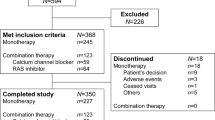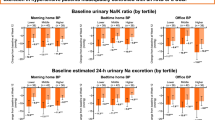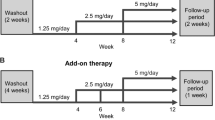Abstract
We conducted a randomised, double-blind, parallel design study comparing the efficacy and tolerability of the angiotensin II receptor antagonist, losartan, alone or with low-dose hydrochlorothiazide (HCTZ) to the dihydropyridine calcium channel blocker, nifedipine GITS (gastro-intestinal therapeutic system), in elderly patients (⩾65 years old) with a diastolic blood pressure (DBP) between 95 and 115 mm Hg. After a placebo wash out period, 140 patients were randomly assigned to receive either losartan 50 mg or nifedipine GITS 30 mg. Patients were evaluated at 4-week intervals during a 12-week treatment period. Patients receiving losartan had HCTZ 12.5 mg added and increased to 25 mg to reduce DBP <90 mm hg. patients receiving nifedipine gits had their dose increased to 60 mg and 90 mg to reduce dbp <90 mm hg. efficacy, tolerability and quality of life were assessed during the 12 weeks on each regimen. patients treated with the losartan regimen (n = 73) had reductions in trough sitting DBP of −10, −13, and −13 mm Hg after 4, 8, and 12 weeks of therapy, respectively. Patients receiving the nifedipine GITS regimen (n = 67) had DBP reductions of −14, −15, and −15 mm Hg, respectively. There were no significant differences in the DBP response between the treatment groups except at week 4 (P < 0.05). similar reductions in systolic bp (sbp) between the two treatment groups were observed at all time points. the percentages of patients in the two treatment groups reaching goal dbp (<90 mm hg or dbp ⩾90 mm hg with a reduction from a baseline of ⩾10 mm hg) were comparable (81% on the losartan regimen and 90% on the nifedipine gits regimen). there were significantly more adverse events reported in patients receiving nifedipine gits when compared to the losartan regimen (54% vs 36%, P < 0.05). a patient-reported symptom inventory also showed that swollen ankles was bothersome in significantly more patients treated with the nifedipine gits regimen when compared to the losartan regimen (24% vs 5%, P = 0.001). Thus, in elderly patients with diastolic hypertension, a regimen of losartan alone or with HCTZ has similar efficacy to a regimen of nifedipine GITS with greater tolerability and less symptom bother due to swollen ankles.
This is a preview of subscription content, access via your institution
Access options
Subscribe to this journal
Receive 12 digital issues and online access to articles
$119.00 per year
only $9.92 per issue
Buy this article
- Purchase on Springer Link
- Instant access to full article PDF
Prices may be subject to local taxes which are calculated during checkout
Similar content being viewed by others
Author information
Authors and Affiliations
Rights and permissions
About this article
Cite this article
Conlin, P., Elkins, M., Liss, C. et al. A study of losartan, alone or with hydrochlorothiazide vs nifedipine GITS in elderly patients with diastolic hypertension. J Hum Hypertens 12, 693–699 (1998). https://doi.org/10.1038/sj.jhh.1000687
Received:
Revised:
Accepted:
Published:
Issue Date:
DOI: https://doi.org/10.1038/sj.jhh.1000687
Keywords
This article is cited by
-
Evaluation of activation energy conformity derived from model-free non-isothermal predictions and Arrhenius isothermal results
Journal of Thermal Analysis and Calorimetry (2017)
-
Spectrum of use for the angiotensin-receptor blocking drugs
Current Hypertension Reports (1999)



